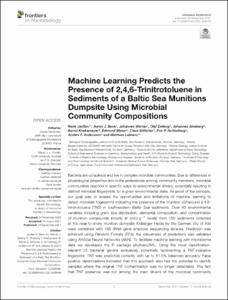| dc.contributor.author | Janssen, René | |
| dc.contributor.author | Beck, Aaron J. | |
| dc.contributor.author | Werner, Johannes | |
| dc.contributor.author | Dellwig, Olaf | |
| dc.contributor.author | Alneberg, Johannes | |
| dc.contributor.author | Kreikemeyer, Bernd | |
| dc.contributor.author | Maser, Edmund | |
| dc.contributor.author | Böttcher, Claus | |
| dc.contributor.author | Achterberg, Eric P. | |
| dc.contributor.author | Andersson, Anders F. | |
| dc.contributor.author | Labrenz, Matthias | |
| dc.coverage.spatial | Baltic Sea | en_US |
| dc.date.accessioned | 2021-12-15T21:23:15Z | |
| dc.date.available | 2021-12-15T21:23:15Z | |
| dc.date.issued | 2021 | |
| dc.identifier.citation | Janßen, R., Beck, A.J., Werner, J.,
Dellwig, O., Alneberg, J.,et al (2021)
Machine Learning Predicts the
Presence of 2,4,6-Trinitrotoluene in
Sediments of a Baltic Sea Munitions
Dumpsite Using Microbial Community
Compositions.
Frontiers in Microbiology, 12:626048, 18pp.
DOI: 10.3389/fmicb.2021.626048 | en_US |
| dc.identifier.uri | https://repository.oceanbestpractices.org/handle/11329/1815 | |
| dc.description.abstract | Bacteria are ubiquitous and live in complex microbial communities. Due to differences in
physiological properties and niche preferences among community members, microbial
communities respond in specific ways to environmental drivers, potentially resulting in
distinct microbial fingerprints for a given environmental state. As proof of the principle,
our goal was to assess the opportunities and limitations of machine learning to
detect microbial fingerprints indicating the presence of the munition compound 2,4,6-
trinitrotoluene (TNT) in southwestern Baltic Sea sediments. Over 40 environmental
variables including grain size distribution, elemental composition, and concentration
of munition compounds (mostly at pmol g1 levels) from 150 sediments collected
at the near-to-shore munition dumpsite Kolberger Heide by the German city of Kiel
were combined with 16S rRNA gene amplicon sequencing libraries. Prediction was
achieved using Random Forests (RFs); the robustness of predictions was validated
using Artificial Neural Networks (ANN). To facilitate machine learning with microbiome
data we developed the R package phyloseq2ML. Using the most classificationrelevant
25 bacterial genera exclusively, potentially representing a TNT-indicative
fingerprint, TNT was predicted correctly with up to 81.5% balanced accuracy. False
positive classifications indicated that this approach also has the potential to identify
samples where the original TNT contamination was no longer detectable. The fact
that TNT presence was not among the main drivers of the microbial community composition demonstrates the sensitivity of the approach. Moreover, environmental
variables resulted in poorer prediction rates than using microbial fingerprints. Our
results suggest that microbial communities can predict even minor influencing factors in
complex environments, demonstrating the potential of this approach for the discovery
of contamination events over an integrated period of time. Proven for a distinct
environment future studies should assess the ability of this approach for environmental
monitoring in general. | en_US |
| dc.language.iso | en | en_US |
| dc.rights | Attribution 4.0 International | * |
| dc.rights.uri | http://creativecommons.org/licenses/by/4.0/ | * |
| dc.subject.other | Munitions | en_US |
| dc.subject.other | Dumpsite | en_US |
| dc.title | Machine Learning Predicts the Presence of 2,4,6-Trinitrotoluene in Sediments of a Baltic Sea Munitions Dumpsite Using Microbial Community Compositions. | en_US |
| dc.type | Journal Contribution | en_US |
| dc.description.refereed | Refereed | en_US |
| dc.format.pagerange | 18pp. | en_US |
| dc.identifier.doi | 10.3389/fmicb.2021.626048 | |
| dc.subject.parameterDiscipline | Anthropogenic contamination | en_US |
| dc.bibliographicCitation.title | Frontiers in Microbiology | en_US |
| dc.bibliographicCitation.volume | 12 | en_US |
| dc.bibliographicCitation.issue | Article 626048 | en_US |
| dc.description.sdg | 14.1 | en_US |
| dc.description.eov | Marine debris | en_US |
| dc.description.methodologyType | Reports with methodological relevance | en_US |
| obps.contact.contactname | Matthias Labrenz | |
| obps.contact.contactemail | matthias.labrenz@ io-warnemuende.de | |
| obps.resourceurl.publisher | https://www.frontiersin.org/articles/10.3389/fmicb.2021.626048/full | |
 Repository of community practices in Ocean Research, Applications and Data/Information Management
Repository of community practices in Ocean Research, Applications and Data/Information Management

